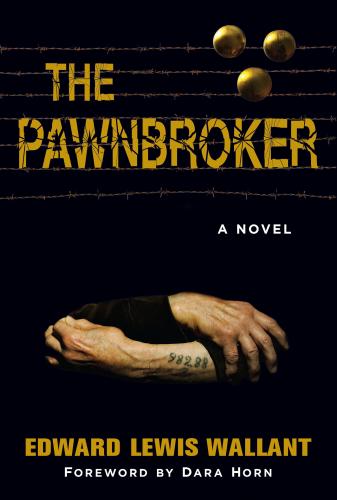PRAISE FOR EDWARD LEWIS WALLANT
“In the short time [Wallant] was writing - about three years wherein he considered himself and was considered a serious writer - he was counted as part of a brilliant group of postwar Jewish American writers - Saul Bellow, Bernard Malamud, Norman Mailer and Philip Roth among them. That Wallant died so young, unable to travel on with these writers, is criminal, especially given how prolific he was. But the novels he finished in his short life are all miniature masterpieces.”
—DAVE EGGERS
“[R]eminiscent of Dostoevski. . . . on every count [The Pawnbroker] deserves the attention of every serious reader.”
—THOMAS LASK, The New York Times
“Edward Lewis Wallant is a gifted writer who probes with a kind of troubled tenderness into pools of human darkness.”
—DAVID BOROFF, Saturday Review
“No contemporary novelist was more gifted in the sheer grace of constructing a novel. . . .”
—CHARLES ALVA HOYT
“[A]n American naturalist in the tradition of Dreiser and Norris. . . .”
—ROBERT W. LEWIS
BY EDWARD LEWIS WALLANT
The Children at the Gate
The Human Season
The Pawnbroker
The Tenants of Moonbloom
This book is a work of fiction. Names, characters, businesses, organizations, places, events, and incidents, either are the product of the author’s imagination or are used fictitiously. Any resemblance to actual persons, living or dead, events or locales, is entirely coincidental.
Copyright © 1961 by Edward Lewis Wallant
Copyright renewed 1989 by Joyce Malkin, Leslie A. Wallant, Kim Wallant
Pereira and Scott Wallant
Published by special arrangement with Houghton Mifflin Harcourt
Publishing Company
All rights reserved.
Published in the United States by Fig Tree Books LLC, Bedford, New York
Jacket design by Christine Van Bree
Interior design by Neuwirth & Associates, Inc.
Library of Congress Cataloging-in-Publication Data Available Upon Request
ISBN 978-1-941493-15-1
Distributed by Publishers Group West
First edition
10 9 8 7 6 5 4 3 2 1
For Joyce, Scott, Leslie, and Kim
CONTENTS
CHAPTER FOUR
CHAPTER FIVE
CHAPTER SIX
CHAPTER SEVEN
CHAPTER EIGHT
CHAPTER NINE
CHAPTER TEN
CHAPTER ELEVEN
CHAPTER TWELVE
CHAPTER THIRTEEN
CHAPTER FOURTEEN
CHAPTER FIFTEEN
CHAPTER SIXTEEN
CHAPTER SEVENTEEN
CHAPTER EIGHTEEN
CHAPTER NINETEEN
CHAPTER TWENTY
CHAPTER TWENTY-ONE
CHAPTER TWENTY-TWO
CHAPTER TWENTY-THREE
CHAPTER TWENTY-FOUR
CHAPTER TWENTY-FIVE
CHAPTER TWENTY-SIX
CHAPTER TWENTY-SEVEN
CHAPTER TWENTY-EIGHT
by Dara Horn
How many lousy Holocaust novels have you read?
If you read much, or really any, contemporary American fiction, the genre of lousy Holocaust novels is surprisingly difficult to avoid. The telltale signs of a lousy Holocaust novel are many, and in most respects they resemble those of all other lousy novels: one-dimensional characters, cardboard backdrops, implausible plot twists, unambiguous conflicts—and most of all, the absence of any challenge to the reader, whose expectations are gleefully enforced at every turn. Adorable child? Check. Hardhearted villain? Check. Feisty heroine? Check. Dramatic setting? Check. Conflict where we know who to root for? Check. Uplifting ending? In most American Holocaust novels, check!
I have nothing against lousy novels. (Without them, how would producers get ideas for lousy movies?) But lousy Holocaust novels are something else: the exploitation of an utterly unredemptive historical catastrophe for the sake of yet another love story or coming-of-age tale or journey of self-discovery, with all the hard work of developing conflict and creating a moral universe done by the historical backdrop alone. I fault The Pawnbroker for unleashing over fifty years of lousy Holocaust novels on the American reading public. It accomplished this, of course, the only way it could: by being an absolute masterpiece.
Why do we read Holocaust novels? To remember, the pious secularists will intone. But what does that mean? If it means remembering the lives of the victims, their individual and collective passions and commitments, then such novels in English have done a particularly poor job. 80% of Jews murdered in the Holocaust were Yiddish speakers, for instance, yet most American readers who could name four concentration camps couldn’t name four Yiddish writers, or even identify Yiddish as a language rather than a dialect. Moreover, most of these novels—the present volume included—don’t even attempt to present any meaningful semblance of prewar European Jewish life, focusing instead on the details of its destruction. This raises a question: Why should we care how these people died, if we don’t care how these people lived?
If our sanctified remembering has nothing to do with remembering people’s lives, then the next logical assumption would be that we are meant to remember their revolting deaths—and that exposing ourselves to the degradation these people suffered will somehow sensitize us to such suffering in the future. But while required readings of Holocaust literature
